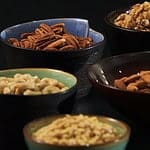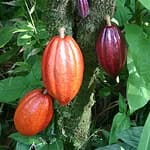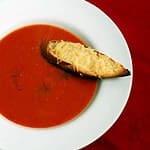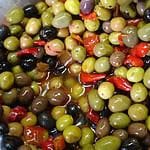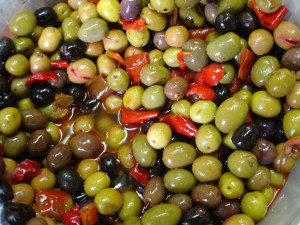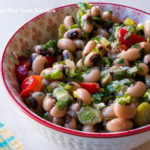Make Ahead Tip For Tea Sandwiches
To enjoy more time with your guests, make tea sandwiches ahead and store them as follows: Line a jelly roll pan with damp paper towels. Place sandwiches in the pan and cover with additional damp paper towels to keep the bread from drying out. Cover the pan tightly with plastic wrap and refrigerate up to four hours.
2 Tablespoons Olive Oil
½ Pound Sweet Italian Sausage (Remove Casings & Crumble)
¼ Teaspoon Red Pepper Flakes
¼ Cup Diced Onion
2 Minced Garlic Cloves
15 Ounces Coarsely Chopped Italian Plum Tomatoes
¾ Cup Heavy Cream
¼ Teaspoon Salt
6 Ounces Pasta of Your Choice
1 ½ Teaspoon Minced Parsley
½ Cup Grated Parmesan cheese
Heat olive oil in a heavy skillet over medium heat. Add the sausage and red pepper flakes. Cook sausage; add onion and garlic until tender. Stir frequently. Add tomatoes, cream and salt. Simmer until slightly thickened. Cook pasta in a large pot of boiling water. Do NOT overcook the pasta. Drain pasta and add to the sauce. Cook for about 2 minutes. Divide between plates and sprinkle with parsley and Parmesan cheese. Serves 2
Toasting Nuts
Toasting nuts brings out their flavor and, in the case of nuts such as hazelnuts, facilitates removal of the skins.
To toast almonds, pecans, walnuts or hazelnuts, preheat the oven to 350° F. Spread the shelled nuts in a single layer on a cookie sheet. Bake, stirring occasionally, until lightly browned and fragrant – usually about 10 minutes. Toast hazelnuts until the skins begin to peel away. Let the nuts cool completely before chopping.
To skin hazelnuts, wrap the still warm toasted nuts in a clean kitchen towel and let stand for about 10 minutes. Using the towel, rub off as much of the skins as possible (all of the skin may not come off).
Know Your Cocoa
Cocoa (theobrama cacao) is a product extracted from the bean of the cacao plant (a tree originally from tropical America). Cocoa is the basic ingredient in chocolate. The different species of cacao are generally divided into two groups: cacao plants that produce superior-quality cocoa and cacao plants that produce ordinary-quality cocoa (used mostly in the industry). The fruit of the cacao plant, its pod, is an oblong berry measuring up to 12 inches long and 3 to 5 inches wide. It contains a gelatinous pulp that harbors 30 to 40 pink or pale purple seeds (beans). These seeds are made up of a kernel, a seed coat and a germ. Only the kernels are eaten, and only after being processed, as they are very bitter.
Cocoa powder is high in starch, which makes it difficult to blend with other substances. Mix it with a cold liquid (if it is hot, lumps will form) or add sugar to it, which separates the starch particles; it can also be mixed after sifting.
Cocoa can be used to flavor cakes, pies, puddings, cookies, sauces, frostings, ice cream, mousses, flans, breads, candies, syrups, milk, drinks and liqueurs.
Not all cocoas are created equal. There is a difference between natural and Dutch process cocoas. Don’t swap cocoa types and do not use mixes for hot chocolate drinks. Use what is recommended in the recipe. Both types of cocoa have rich chocolate flavor, are equally delicious, and contain between 8 and 24 percent fat.
In my kitchen, I usually use natural cocoa because it is readily available. Its acidity works in tandem with the baking soda in a batter to create carbon dioxide bubbles, which leaven cakes. Dutch process cocoa is treated with an alkali agent that neutralizes and removes some of the cocoa’s acidity. The process was developed in the Netherlands in the mid-1800s, hence the name. This process changes the cocoa’s chemical composition, so it doesn’t need to be combined with baking soda. You will find Dutch process cocoa at specialty food stores and most supermarkets. Look closely at the label. Some cocoas are alkalized even if the label doesn’t clearly state it.
Soup Basics
I love soup! Nothing makes me feel more comforted than a nice homemade soup. From a traditional tomato to French Onion to Tom Yum there is something so special about having soup.
Here are some of the most popular types of soup:
Bisque: A classic French soup with a rich, creamy texture. It is usually made from shellfish and thickened with rice.
Broth: A flavorful liquid made from simmered meat, fish, poultry and or vegetables.
Chowder: Hearty and chunky, this soup is chockfull of fish, shellfish and/or vegetables. Clam chowder has been popular in New England since colonial times.
Consommé: Broth that has been clarified into a crystal-clear liquid.
Gumbo: One of the signature dishes of Cajun cooking, gumbo is a thick soup that can contain chicken, duck, seafood or ham and vegetables such as tomatoes, onion, bell peppers and celery. It is thickened with a roux (a browned butter and flour mixture), okra and/or file´ (ground sassafras leaves) and is served over white rice.
Stock: Similar to broth but made from bones, often roasted, that are simmered with water and/or vegetables.
You’ve Touched My Heart
You’ve Touched My Heart
You’ve Given Me A Reason
For Smiling Once Again,
You’ve Filled My Life With Peaceful Dreams
And You’ve Become My Closest Friend.
You’ve Shared Your Heartfelt Secrets
And Your Trust You’ve Given Me,
You Showed Me How To Feel Again
To Laugh, And Love, And See.
If Life Should End Tomorrow
And From This World I Should Part,
I Shall Be Forever Young
For You Have Touched My Heart.
Tofu Basics
Tofu, also known as bean curd, is a good source of protein, phytochemicals (chemical compounds that occur naturally in plants) and isoflavonoids (group of biologically active phytochemicals. Additionally, it has not cholesterol. Making tofu is similar to making simple cheeses (pressed curd tofu) or yogurt (silken tofu).
Before cooking tofu, drain, slice or cube it and blot with paper towels to remove excess water. This allows more room for marinades to be absorbed and will help prevent spattering.
Each tofu has its best use. Here is a quick reference to check before you buy:
*Extra-Firm: Ideal for when you ant tofu that won’t fall apart or if you want
Break it into crumbles.
*Firm: All-purpose tofu, strong enough to withstand frying and sautéing. It
Retains some delicacy that extra-firm tofu lacks.
*Flavored: Marinated, ready to use and available in a variety of flavors.
*Silken: Sold in shelf-stable packages; add to salads, puree for salad
Dressings and smoothies or scrambles with eggs.
*Soft: Delicate custard like texture, which makes it a perfect choice for
Salads, smoothies, baked goods, sauces and dips.
Marsala Wine
Marsala, Italy’s most famous fortified wine is produced by a process similar to the one used in Spain to make sherry. Marsala is made in several different styles:
*Secco – Dry
*Semisecco – Semisweet
*Dolce – Sweet
It is also classified based on its flavor characteristics and aging.
*Fine – Usually aged less than 1 year
*Superiore – Aged at least 2 years
*Superiore Riserva – Aged at least 4 years
*Vergine e/o Soleras – Aged at least 5 years
*Vergine e/o Soleras Stravecchio or Vergine e/o Solveras Riserva – Aged at
least 10 years
How To Pit An Olive
You can buy pitted olives, but I think unpitted olives are more flavorful and it is very easy to pit them. Simply place the olives on a cutting board. With the bottom of a small heavy saucepan, a rolling pin or the flat side of a large chef’s knife, press down hard on the olives, one at a time, to split them open. Lift out the pits with your fingers and discard.





